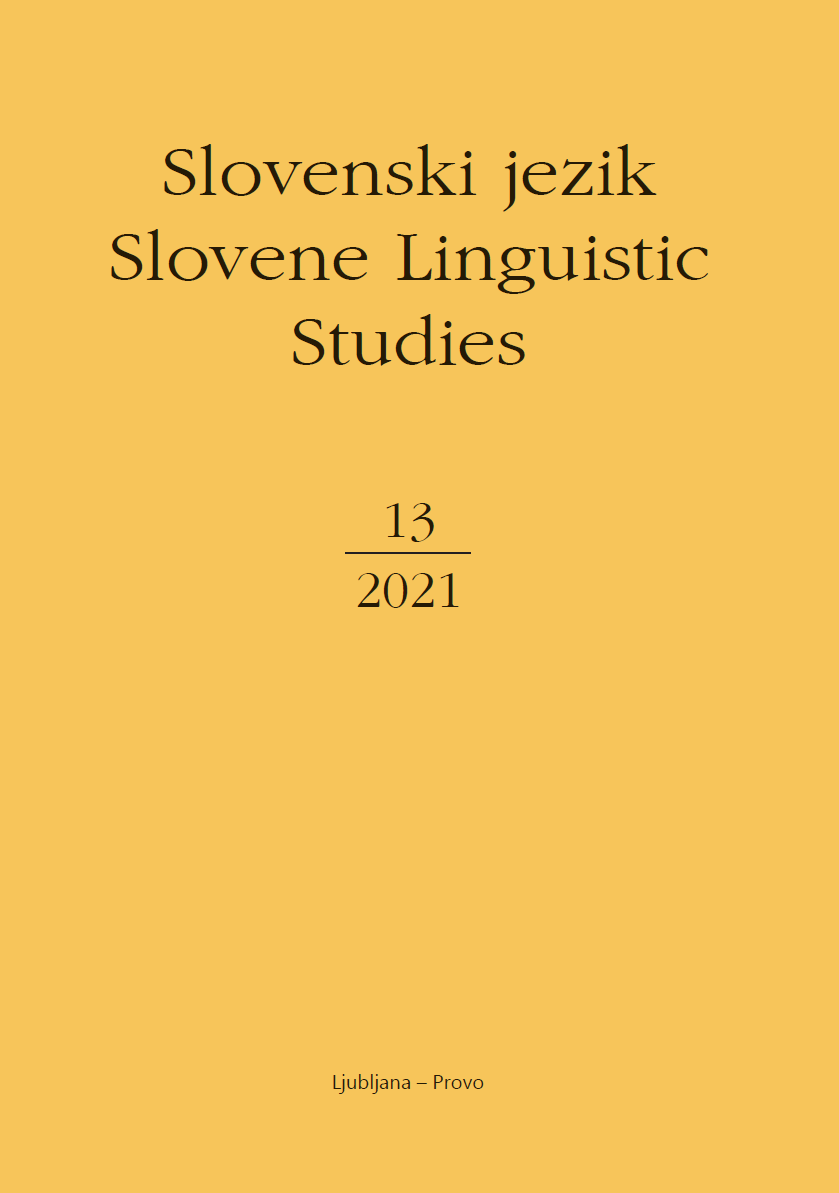PIE *peh2ur ’fire’. Two Slavic etymologies
DOI:
https://doi.org/10.3986/sjsls.13.1.01Keywords:
Etymologies, Proto-Slavic, Balto-Slavic, Indo-European, FolkloreAbstract
This study investigates two traditional Proto-Slavic etyma. (1.a) PS *netopyŕĭ, *netŭpyŕĭ ‘bat’. The former has widespread descendants in East and West Slavic and Western South Slavic; the latter, attested in Middle Russian, has no known modern reflexes. (1.b) PS *netopyŕĭ, *netŭpyŕĭ ‘moth > butterfly’. The former is attested as Pb. netüpar ‘butterfly’; the latter as SC lȅptīr, lȅpīr, Mn lȅper ‘butterfly’. Comparison with PS *noťĭlegŭ ‘night lodging’ points to a PPS *[nekt-i+pūr]-ja- ‘[night-time fire] one’, a juxtaposition of PPS *nekt-i (cf. OR nočĭ adv. ‘at night’) and *pūr ‘fire’. Moths and bats naurally occur around an out-door fire at night. (2) PS *ǫpyŕĭ ‘revenant, monster’ is resolved as PPS *[un-pūr]-ja- ‘one without fire’. The socio-cultural context for the word’s creation is the ancient Slavic cremation culture, in which the untimely dead were thought to be tools of evil forces. The remarkable archaisms in these words are commented on in the Conclusion.
Downloads
References
Andersen, Henning. 1999. The Western South Slavic contrast Sn. sah-ni-ti || SC sah-nu-ti. Slovenski jezik/Slovene Linguistic Studies 2: 47–62.
Andersen, Henning. 2001. Markedness and the theory of linguistic change. In: H. Andersen (ed.), Actualization. Amsterdam: Benjamins. 19–57.
Andersen, Henning. 2020. On the formation of the Common Slavic koiné. In: V. Boček, N. Jansens, T. Klír (eds.). New perspectives on the early Slavs and the rise of Slavic: Contact and migration. Heidelberg: Winter. 11–42.
Bezlaj, France. 1982. Etimološki slovar slovenskega jezika, vol. 2. K–O. Ljubljana: Mladinska knjiga.
Boryś, Wiesław. 1975. Prefiksacja imienna w językach słowiańskich. (Monografie slawistyczne, 31.) Wrocław: Ossolineum.
Brückner, Aleksander. 1927. Słownik etymologiczny języka polskiego. Cracow: Krakowska spółka wydawnicza. Reprint, Warsaw: Wiedza Powszechna, 1974.
Derksen, Rick. 2008. Etymological Dictionary of the Slavic Inherited Lexicon. Leiden: Brill.
Derksen, Rick (ed.) 2010. Etymological Dictionary of the Baltic Inherited Lexicon. Available at: https://dictionaries.brillonline.com/search#dictionary=baltic&id=bl ti694 (24. 3. 2021).
Diels, Paul. 1932. Altkirchenslavische Grammatik, Teil 1. Grammatik. Heidelberg: Winter. Dingley, John. 2006. Slavic *netopyrь in a broader context. Journal of Slavic Linguistics and Poetics 44/45: 85–103 (2002–2003).
Gamkrelidze, T. V., Ivanov, V. V. 1984. Indoevropejskij jazyk i indoevropejcy.
Rekonstrukcija i istoriko-tipologičeskij analiz prajazyka i protokul’tury. Tbilisi: Izdatel’stvo tbilisskogo universiteta.
Gluhak, A. 1993. Hrvatski etimološki rječnik. Zagreb: August Cesarec.
Grammont, Maurice. 1933. Traité de phonétique (8th edition, 1965). Paris: Delagrave. Herrmann, Joachim (ed.). 1985. Die Slawen in Deutschland. Geschichte und Kultur der slawischen Stämme westlich der Oder und Neiße vom 6. bis 12. Jahrhundert. Ein Handbuch. Berlin: Akademie-Verlag.
Hrynčenko, Borys [D.] 1907–09. Slovar’ ukrains’koji movy/Slovar’ ukrainskogo jazyka.
Reprint, Kiev: Akademija Nauk Ukrajins’koji RSR, 1958–1959.
Kloekhorst, Alwin (ed.). 2007. Etymological Dictionary of the Hittite Inherited Lexicon. Leiden: Brill. Available at: https://dictionaries.brillonline.com/search#dictionary-hittite&id=hi0725 (24. 3. 2021), First published online October 2010.
Kortlandt, F. 1979. Three problems of Slavic phonology. Zbornik za filologiju i lingvistiku 22/2: 57–63.
Kroonen, Guus (ed.). 2009. Etymological Dictionary of Proto-Germanic. Available at: https://dictionaries.brillonline.com/search#dictionary=proto_germanic&id=21064 (24. 3. 2021). First published online October 2010.
Litavrin, G. G., S. A. Ivanov, V. K. Ronin (eds.). 1995. Svod drevnejšix pis’mennyx izvestij o slavjanax, vol. 2. (7.–9. st.). Moscow: Institut slavjanovedenija i balkanistiki & Vostočnaja literatura
Lukinova, T. B. 1986. Leksika slavjanskogo jazyčestva, Ètimologija 1984. 119–124. Majer, Marek. Forthcoming. The origin of East South Slavic gerunds in -nik.
Miklosich, Franz. 1886. Etymologisches Wörterbuch der slavischen Sprachen. Vienna: Braunmüller. Reprint, Amsterdam: Philo Press.
Niderle [Niederle], Lubor. Slavjanskie drevnosti. Moscow: Izdatel’stvo inostrannoj literatury.
Olander, Thomas. 2015. Proto-Slavic Inflectional Morphology. A comparative handbook. Leiden: Brill.
Olesch, Reinhold. 1983–1984. Thesaurus linguae dravaenopolabicae. 1–3. Cologne: Böhlau.
Ostrowski, Donald (ed.). 2003. The Povest’ vremennyx let, an interlinear collation and paradosis, 1–3. With David J. Birnbaum, Horace G. Lunt. Cambridge, Mass.: Harvard University Press.
Rix, Helmut (ed.). 2001. Lexikon der indogermanischen Verben. Die Wurzeln und ihre Primärstammbildungen. (Second edition.) Wiesbaden: Reichert.
Rybakov, B. A. 1994. Jazyčestvo drevnix slavjan. Moscow: Nauka.
Sedov, V. V. 1990. Pogrebal’nyj obrjad slavjan v načale srednevekov’ja. In: V. V. Ivanov, L. G. Nevskaja (eds.). Issledovanija v oblasti balto-slavjanskoj duxovnoj kul’tury. Pogrebal’nyj obrjad. Moscow: Nauka. 170–182.
Sedov, V. V. 1994. Slavjane v drevnosti. Moscow: Naučno-proizvodstvennoe blagotvoritel’-noe obščestvo. Fond arxeologii.
Sjöberg, A. 1982. Pop Upir’ Lichoj and the Swedish rune-carver Ofeigr Upir. Scando- Slavica 28.109–124.
Skok, Petar. 1971–1974. Etimologijski rječnik hrvatskoga ili srpskoga jezika. 1–4. Zagreb: Jugoslavenska akademija znanosti i umjetnosti. th Smirnickij, A. I. 1992. Russko-anglijskij slovar’/Russian-English Dictionary. (16 edition.) Moscow: Russkij jazyk.
Snoj, Marko. 1997. Slovenski etimološki slovar. Ljubljana: Mladinska knjiga.
Stachowski, Kamil, Olaf Stachowski. 2017. Possibly Oriental elements in Slavonic folklore. Upiór ~ wampir. In Michał Németh, Barbara Podolak, Mateusz Urban (eds.). Essays in the History of Languages and Linguistics. Dedicated to Marek Stachowski on the occasion of his 60th birthday. Cracow: Księgarnia Akademicka. 643–693.
Stanisławski, Jan. 1995. Wielki słownik polsko-angielski. 1–2. Warsaw: Philip Wilson. Trávníček, František. 1952. Slovník jazyka českého. Prague: Slovanské nakladatelství. Trubačev, O. N. 1997. *ne(k)topyrĭ. Ètimologičeskij slovar’ slavjanskix jazykov 24: 143– 145. Moscow: Nauka.
Vaan, Michiel de. (ed.). 2008. Etymological Dictionary of Latin and the other Italic Languages. Leiden: Brill.
Vaillant, André. 1958. Grammaire comparée des langues slaves. Vol. 2.1. Flexion nominale. Lyon – Paris: IAC.
Vaillant, André. 1974. Grammaire comparée des langues slaves. Vol. 4. La formation des noms. Paris: Klincksieck.
Valencova, Marina M. 2013. Ètnolingvističeskij kommentarij k ètimologii slov mara i upyr’. In: Bohumil Vykypěl, Vít Boček (eds.), Etymology: An Old Discipline in New Contexts. Prague: Nakladatelství Lidové noviny.
Vasmer, Max. 1953–1957. Russisches etymologisches Wörterbuch. 1–3. Heidelberg: Winter. Translated: O. N. Trubačev. 1964–1973. Ètimologičeskij slovar’ russkogo jazyka. Moscow: Progress.
Downloads
Published
Versions
- 2023-03-27 (2)
- 2021-10-12 (1)
How to Cite
Issue
Section
License

This work is licensed under a Creative Commons Attribution-NonCommercial-NoDerivatives 4.0 International License.
Authors guarantee that the work is their own original creation and does not infringe any statutory or common-law copyright or any proprietary right of any third party. In case of claims by third parties, authors commit their self to defend the interests of the publisher, and shall cover any potential costs.
More in: Submission chapter





